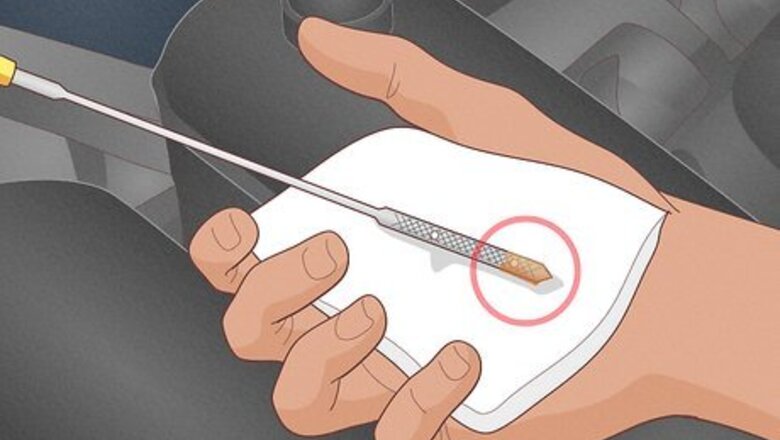
views
Low Oil Levels
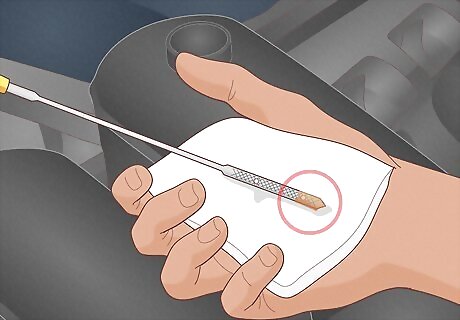
Low oil levels are an indication that your current oil is nearing the end of its life. Over time, small particles of oil burn off or dissipate. Some of the oil slowly dries out inside of the engine’s channels. Eventually, if you don’t get your oil changes on time, this can lead to a low overall engine oil level. If you recently got an oil change or you refilled the oil and your levels are low again, you probably have a leak that needs to be repaired. How to check: Locate the engine oil dipstick, which is usually on the edge of the engine itself (it will usually say something like 5W-20 or 0W-20 on it to indicate the type of oil your engine needs). With a cold car, remove the dipstick, wipe it clean, and stick it back into the reservoir. Remove it again and check where the oil levels are. If they’re near the bottom hashmark, you’re low.
Dirty Oil on Dipstick
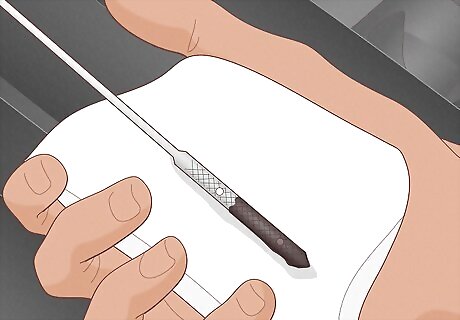
Fresh engine oil is a light brown color. It may even look a little red if you hold it up to the light. But the longer your oil cycles through your system, the dirtier and dirtier it will get. If you notice that your engine oil is almost pitch black and thicker than it should be, it’s a huge signal that it’s time for an oil change. How to check: Grab a bright, white napkin. Locate the engine oil dipstick and remove it. Rub the dipstick dry on the napkin and inspect it. If it’s dark brown, black, and/or coming off in thick globs, the oil is likely spent and it’s time for a change.
Oil Change Light Is On
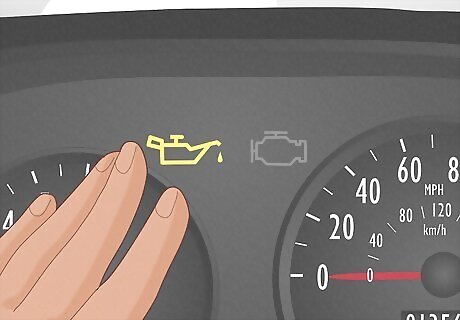
Most modern vehicles are equipped with an automated system that monitors the quality and pressure of the oil in your engine. When it’s time for a fresh batch of oil, those sensors will illuminate a light on your dashboard or a message on your computer screen. This light will also come on if your vehicle suddenly loses oil pressure. If you have a check engine light and an oil pressure light pop on at the same time, pull over. You probably have a bad engine oil leak. How to check: Scan your dashboard for any illuminated lights. The oil warning light looks like an old-school canister with a single drop coming out of the spout. If this light is on, something is off with your engine’s oil system and it is further proof it’s time for an oil change.
Burnt Odors in Cabin
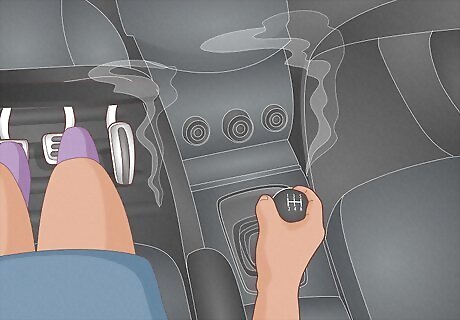
Engine oil is designed to prevent overheating. By keeping the gears lubricated, it prevents the friction between components from absorbing any heat. But if your oil levels are low or the engine is super old and degraded, it may fail to keep the gears lubricated. That heat will eventually begin burning away the old oil, which will cause a burning, smokey odor in your vehicle. That burning aroma will likely get worse the longer or the faster you drive. How to check: Turn your vehicle on and turn the heat on the lowest setting available. Wait a minute or so and then take a deep whiff of the air coming out of your vents. Does something smell like it’s burning? If so, you’re probably burning oil. Smell something sweet, instead? That’s engine coolant. You have a crack or leak in your coolant lines and it’s probably time for a coolant flush.
Reduced Fuel Economy
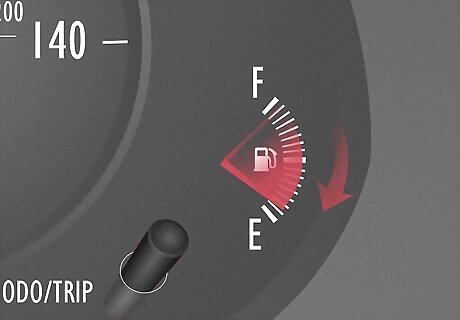
Your engine oil helps your engine’s components move smoothly, but if your oil is spent, those components will experience more friction than they should. This will reduce your engine’s overall efficiency, and in turn, cause your car to operate worse than it normally would. How to check: Monitor how long a full tank gets you and keep track of how often you have to fill your gas up. Also, pay attention to how your vehicle handles when you accelerate and get up to speed on the highway. If your engine performance is extremely poor, low oil could be the culprit.
Strange Noises in Engine Bay
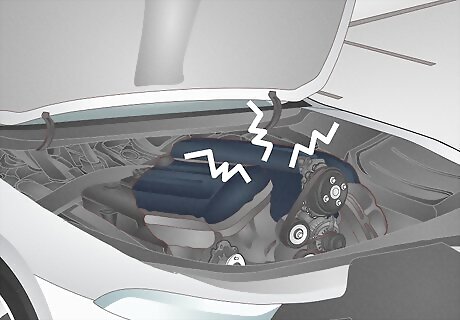
When your engine oil is spent, your engine isn’t getting the lubrication it needs. Without adequate lubrication, all of the gears and cylinders in your engine will start to make noise. This will usually take the form of a consistent rattling noise, but you may also hear grinding, knocking, or clanking noises as well. How to check: Turn your engine on and idle for a moment. Then, pop the hood and listen. If your engine doesn’t have its normal, consistent buzzing whir and you hear anything that sounds like metal rubbing against metal, it’s probably time for an oil change.
Engine Overheating
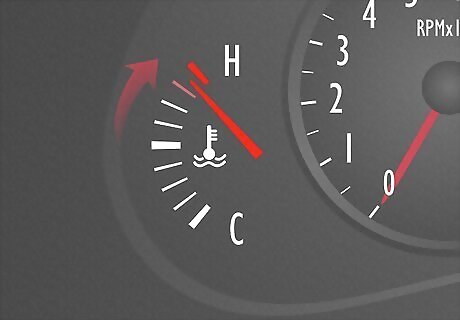
Oil’s secondary job is to prevent engine overheating. By keeping the gears lubricated, the oil prevents excess engine component friction from generating heat. But without enough fresh oil, that heat will begin building up. How to check: Monitor your temperature gauge while you’re driving. If the dial moves up while you’re driving at a normal speed, it’s a huge sign your engine isn’t dissipating heat properly. If the temperature dial reaches the red “danger” area, pull over and turn the vehicle off. Pushing the temperature limits of your engine can lead to a fire or catastrophic damage. If the temperature is high and you 100% cannot pull over, turn the heat on inside of your car and lower the windows. This will help relieve some pressure on your engine.
Dark Exhaust Fumes

One of your engine oil’s tertiary functions is to remove debris and contamination from your engine’s system. Any junk in your engine oil should be captured by your oil filter, but if you’re low on oil or the oil is spent, it may struggle to get rid of everything it normally would. So what happens to all of that debris? It burns. This will result in black o dark blue smoke coming from your exhaust. How to check: Check the exhaust pipe of your vehicle when your engine is idling. If you see any dark smoke, it’s a sign the oil needs to be changed. Just FYI, white smoke would be a sign of a coolant leak.
Engine Stalls
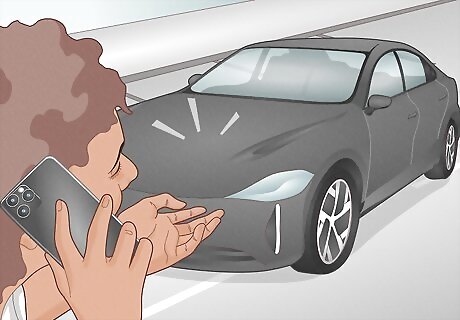
Your engine oil has to be very low and very old for stalls to occur, but if you neglect the oil change for long enough, you will eventually run into stalls. This occurs when either the engine sensors detect a dangerously low level of oil, or oil isn’t circulating throughout the entire engine. The engine will shut off to avoid a fire or catastrophic damage, and you’ll lose the ability to accelerate. If you run into this problem, your vehicle is not safe to drive. If you aren’t going to change the oil at home, get it towed to the mechanic. Stalls can easily lead to crashes if they occur at a dangerous time. How to check: Don’t try testing this one out. Pushing an engine low on oil into stall conditions is a fire risk, so pushing your engine in this direction isn’t a good idea.
No Recent Oil Change
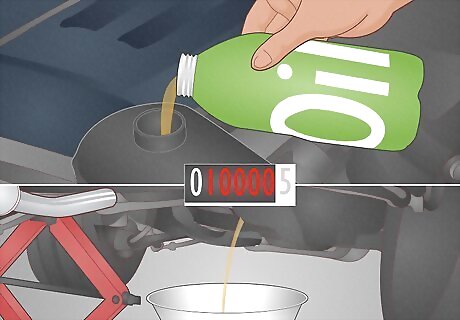
Automotive expert, Tom Eisenberg, weighed in on how often you need an oil change: “Most vehicles have conventional oil … and that lasts anywhere from 3,500 to 5,000 miles. If you drive a newer car or a German car, those usually take a higher grade of synthetic oil, which just lasts a little bit longer, and coats a little bit better. And that should probably last around 7,500 to 10,000 miles.” Check your user manual if you really aren’t sure whether it’s time for an oil change or not. The recommended mileage between oil changes is typically documented there. How to check: Has it been over a year since your last oil change? If so, it’s almost positively time for an oil change. Check the corners of the inside of your windshield, too. Most mechanics will put a sticker in one of those corners indicating when it’s time to get your next oil change.
















Comments
0 comment